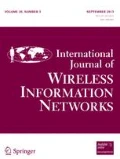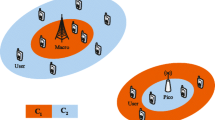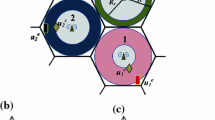Abstract
Frequency Reuse (FR) is an efficient approach to improve the network performance in a multi-cell cellular network. In this paper, we investigate the performance of heterogeneous networks utilising two well-known frequency reuse algorithms, called Strict FR and Soft FR, with a reuse factor of \(\varDelta\) (\(\varDelta > 1\)). Based on a two-phase operation of the FR algorithm, we develop a new approach to analyse cellular networks based on the Poisson Point Process (PPP) model which successfully demonstrates the impact of the network parameters (such as the number of allocated Resource Blocks (RBs) and bias factor) and FR parameters (such as Base Station (BS) transmit power) on the performance of a user and overall network. Compared to related works, we propose the following novel approaches: (i) we investigate flexible FR networks in which users have connections with the BSs which deliver the highest performance; (ii) the BS observes SINR on the data channel to classify each user into either a Cell-Edge User (CEU) or Cell-Center User (CCU); (iii) the initial state of the network is considered to establish the initial network interference when new users arrive and request connections to the BSs. In the case of a single-tier network, it is proved that our analytical approach is more accurate than previous works. In the case of a two-tier network, the analytical results indicate that compared to the 3GPP model, our proposed model not only reduces up to 40.79% and 3.8% power consumption of a BS on the data channel but also achieves 16.08% and 18.63% higher data rates in the case of Strict FR and Soft FR respectively. Furthermore, the paper presents an approach to find an optimal value of SINR thresholds and bias factor to achieve the maximum network performance.












Similar content being viewed by others
References
3GPP-TSG-RAN-R1-050738, Interference mitigation considerations and results on frequency Reuse (September, 2005, Siemens).
F. Mhiri, K. Sethom and R. Bouallegue, A survey on interference management techniques in femtocell self-organizing networks, J. Netw. Comput. Appl., Vol. 36, No. 1, pp. 58–65, 2013. https://doi.org/10.1016/j.jnca.2012.04.021.
S. C. Lam and K. S. Sandrasegaran, Performance analysis of fractional frequency reuse in uplink random cellular networks, Phys. Commun., 2017. https://doi.org/10.1016/j.phycom.2017.09.008.
T. D. Novlan, Fractional frequency reuse for multi-tier cellular networks, 2012. https://repositories.lib.utexas.edu/handle/2152/ETD-UT-2012-05-5184
T. D. Novlan, R. K. Ganti, A. Ghosh and J. G. Andrews, Analytical evaluation of fractional frequency reuse for OFDMA cellular networks, IEEE Trans. Wireless Commun., Vol. 10, pp. 4294–4305, 2011.
H. Zhuang and T. Ohtsuki, A model based on Poisson point process for downlink K tiers fractional frequency reuse heterogeneous networks, Phys. Commun., Vol. 1, No. 13, pp. 3–12, 2014.
S. Kumar, S. Kalyani and K. Giridhar, Optimal design parameters for coverage probability in fractional frequency reuse and soft frequency reuse, IET Commun., Vol. 9, No. 10, pp. 1324–1331, 2015.
H.-S. Jo, Y. J. Sang, P. Xia and J. Andrews, Heterogeneous cellular networks with flexible cell association: a comprehensive downlink SINR analysis, IEEE Trans. Wireless Commun., Vol. 11, No. 10, pp. 3484–3495, 2012. https://doi.org/10.1109/TWC.2012.081612.111361.
J. Moller and R. P. Waagepeterse, Statistical inference and simulation for spatial point processes, CRC PressNew York, 2003.
F. Baccelli, M. Klein, M. Lebourges and S. Zuyev, Stochastic geometry and architecture of communication networks, Telecommun. Syst., Vol. 7, No. 1, pp. 209–227, 1997. https://doi.org/10.1023/A:1019172312328.
T. D. Novlan, R. K. Ganti, A. Ghosh and J. G. Andrews, Analytical evaluation of fractional frequency reuse for heterogeneous cellular networks, IEEE Trans. Commun., Vol. 60, No. 7, pp. 2029–2039, 2012. https://doi.org/10.1109/TCOMM.2012.061112.110477.
S. C. Lam, K. Sandrasegaran and P. Ghosal, Performance analysis of frequency reuse for ppp networks in composite Rayleigh-Lognormal fading channel, Wireless Personal Commun., 2017. https://doi.org/10.1007/s11277-017-4215-2.
Y. Lin, W. Bao, W. Yu and B. Liang, Optimizing user association and spectrum allocation in HetNets: a utility perspective, IEEE J. Sel. Areas Commun., Vol. 33, No. 6, pp. 1025–1039, 2015. https://doi.org/10.1109/JSAC.2015.2417011.
Y. Lin and W. Yu. Optimizing user association and frequency reuse for heterogeneous network under stochastic model. In: IEEE Global Commun, Conf. (GLOBECOM). 2013. pp. 2045–2050. https://doi.org/10.1109/GLOCOM.2013.6831376.
D. Cao, S. Zhou and Z. Niu, Improving the energy efficiency of two-tier heterogeneous cellular networks through partial spectrum reuse, IEEE Trans. Wireless Commun., Vol. 12, No. 8, pp. 4129–4141, 2013. https://doi.org/10.1109/TWC.2013.052213.121751.
S. E. Sagkriotis and A. D. Panagopoulos, Optimal FFR policies: maximization of traffic capacity and minimization of base station’s power consumption, IEEE Wireless Commun. Lett., Vol. 5, No. 1, pp. 40–43, 2016. https://doi.org/10.1109/LWC.2015.2491943.
L. Su, C. Yang, C. Li. Energy and spectral efficient frequency reuse of ultra dense networks. In: IEEE Trans. Wireless Commun. Vol. 5(8), pp 5384–5398 (2016) https://doi.org/10.1109/TWC.2016.2557790.
Z. Ning, Q. Song, L. Guo and X. Kong, A novel adaptive spectrum allocation scheme for multi-channel multi-radio wireless mesh networks, J. Netw. Comput. Appl., Vol. 56, No. Supplement C, pp. 19–27, 2015. https://doi.org/10.1016/j.jnca.2015.06.004.
3GPP TS 36.213 version 8.8.0 Release 8, LTE; Evolved Universal Terrestrial Radio Access (E-UTRA); physical layer procedures, 2009.
HUAWEI TECHNOLOGIES CO., LTD, eLTE2.2 DBS3900 LTE FDD Basic Feature Description, 2014.
Author information
Authors and Affiliations
Corresponding author
Additional information
Publisher's Note
Springer Nature remains neutral with regard to jurisdictional claims in published maps and institutional affiliations.
Appendices
A. Theorem 2—CCU Classification
The average probability where the user is served as a CCU in Tier-k of Soft FR is given by
where \(SNR_k=\frac{P_k}{\sigma ^2}\); (a) follows the assumption that the channel fading has Rayleigh distribution.
By substituting Eq. (8), the expectation can be presented as the product of \({\mathbb {E}}(\phi |r_k)\) and \({\mathbb {E}}(1|r_k)\) where
in which \(T_k\frac{\phi _jP_j}{P_k}r_k^{\alpha _k}=s_{jze}\) and \(T_k\frac{P_j}{P_k}r_k^{\alpha _k}=s_{jzc}\).
Evaluating \({\mathbb {E}}(\phi |r_k)\) and since \(g_{jz_e}\) is exponential RV, we have
in which (a) is obtained by using the properties of PPP probability generating function and \(r_j>\sqrt{C_j}r^{\alpha _k/\alpha _j}\); (c) is obtained by employing a change of variables \(x=C_jr_k^{\frac{2\alpha _k}{\alpha _j}} r_{jz_e}^{-2}\).
Substituting \({\mathbb {E}}(\phi _k|r_k)\) and \({\mathbb {E}}(1|r_k)\) into Eq. (29), then the results in Theorem 4.2 is obtained
B. Theorem 3—CCU Under Strict FR
The average coverage probability of a CCU under the Strict FR is given by
in which (a) follows the Bayes rules and (b) follows the assumption that the fading channel coefficients are independent RV and conditioning on \(r_k\).
The expectation in the numerator can be computed based on the approach in [5]
where \(T_k\frac{P_j}{P_k}\frac{r_{jz_c}^{-\alpha _j}}{r_k^{-\alpha _k}}=s_{z_c}\) and \({\hat{T}}_k\frac{P_j}{P_k}\frac{r_{jz_c}^{-\alpha _j}}{r_k^{-\alpha _k}}={\hat{s}}_{z_c}\); and the second equality follows the properties of the indicator function.
Using the properties of the PPP probability generating function with \(r_{jz_c}>\sqrt{C_j}r^{\alpha _k/\alpha _j}\) and employing a change of variable \(x=C_jr_k^{\frac{2\alpha _k}{\alpha _j}} r_{jz_c}^{-2}\);, then
in which \(\upsilon _j^{(oc)}(T_k)={\int _{0}^{1}}\frac{\epsilon _j^{(oc)}}{\frac{1}{T_k}\frac{B_j}{B_k}x^{2-\alpha _j/2}+x^{2}}dx\); \(\upsilon _j^{(c)}({\hat{T}}_k)={\int _{0}^{1}}\frac{\epsilon _j^{(c)}}{\frac{1}{{\hat{T}}_k}\frac{B_j}{B_k}x^{2-\alpha _j/2}+x^{2}}dx\) and
\(\kappa ^{(c)}(T_k,{\hat{T}}_k)={\int _{0}^{1}} \frac{\epsilon _j^{(oc)}\epsilon _j^{(c)}}{x^2\left( \frac{1}{T_k}\frac{B_j}{B_k}x^{-\alpha _j/2}+1\right) \left( \frac{1}{{\hat{T}}_k}\frac{B_j}{B_k}x^{-\alpha _j/2}+1\right) }\)
C. Theorem 4—CEU Under Strict FR
The average coverage probability of a CEU under the Strict FR is evaluated by
The expected value of the numerator can be separated into two expectations in which the first one is evaluated using the same approach as in Appendix A, i.e, \({\mathbb {E}}\left[ e^{-\frac{{\hat{T}}_k}{\phi _k P_k}\left( I_{Str}^{(e)}+\sigma ^2\right) r_k^{\alpha _k}}\right] =e^{-\frac{{\hat{T}}_kr_k^{\alpha _k}}{\phi _kSNR_k}-\pi \lambda _k\epsilon _k^{(e)2} r_k^2 \upsilon _j^{(e)}({\hat{T}}_k)}\), and the second one can be computed in the following steps
in which \(T_k\frac{r_{jz_c}^{-\alpha _j}}{r_k^{-\alpha _k}}=s_{z_c}\) and \({\hat{T}}_k\frac{\phi _j}{\phi _k}\frac{r_{jz_e}^{-\alpha _j}}{r_k^{-\alpha _k}}={\hat{s}}_{z_e}\).
During the establishment phase, the user may experience the ICI from all BSs while the CEU is only affected by \(\frac{1}{\varDelta _j}\) BSs, thus \(\theta _j^{(e)}\) is the subset of \(\theta _j^{(c)}\). Furthermore, since in PPP, each point is stochastically independent to all other points, \(\theta _j^{(e)}\) and \(\theta _j^{(c)}\backslash \theta _j^{(e)}\) are independent in which the density of BSs of \(\theta _j^{(c)}\backslash \theta _j^{(e)}\) is \(\frac{\varDelta _j-1}{\varDelta _j}\lambda _j\) and of \(\theta _j^{(e)}\) is \(\frac{1}{\varDelta _j}\lambda _j\). Therefore, the expectation equals
in which \(s_{z_e}=T_k\frac{r_{jz_e}^{-\alpha _j}}{r_k^{-\alpha _k}}\).
Employing the properties of the PPP probability generating function with \(r_{jz_c}>\sqrt{C_j}r^{\alpha _k/\alpha _j}\) and the changes of variables \(x=C_jr_k^{\frac{2\alpha _k}{\alpha _j}} r_{jz_c}^{-2}\) for the first part and \(x=C_jr_k^{\frac{2\alpha _k}{\alpha _j}} r_{jz_e}^{-2}\) for the second part, the expectation equals
in which \(\upsilon _j^{(e)}({\hat{T}}_k)={\int _{0}^{1}}\frac{\epsilon _j^{(e)}}{\frac{1}{{\hat{T}}_k}\frac{\phi _k}{\phi _j}\frac{B_j}{B_k}x^{2-\alpha _j/2}+x^{2}}dx\)
and \(\kappa (T_k,{\hat{T}}_k)={\int _{0}^{1}} \frac{\epsilon _j^{(oc)}\epsilon _j^{(c)}}{x^2\left( \frac{1}{T_k}\frac{B_j}{B_k}x^{-\alpha _j/2}+1\right) \left( \frac{1}{{\hat{T}}_k}\frac{\phi _k}{\phi _j}\frac{B_j}{B_k}x^{-\alpha _j/2}+1\right) }\); and \(\upsilon _j^{(oc)}(T_k)\) is defined in Eq. (37).
The expectation of the denominator in Eq. (35) is computed by Appendix A, then
Substituting Eqs. (40) and (41) into Eq. 35, Theorem 4 is proved.
D. Theorem 5—CCU Under Soft FR
The coverage probability of a CCU under the Soft FR network is obtained by
Substituting Eq. (8) into Eq. (42), the second element of the integrand in the numerator of (42) can be evaluated by using the approach in [5]:
in which (c) follows the fact that in a PPP network model, each BS is distributed stochastically independent to all the BSs and the fading power gains are independent RVs.
The first element of Eq. (43) can be evaluated as follows
where (d) follows the properties of the indicator function and by letting \(T\frac{P_j}{P_k}r_k^{\alpha _k}=s_{jze}\) and \({\hat{T}}_k\frac{P_j}{P_k}r_k^{\alpha _k}={\hat{s}}_{jze}\); (e) follows the assumption that the channel fading has a Rayleigh distribution; (f) follows the properties of the PPP probability generating function with \(r_{jz_c}>\sqrt{C_j}r^{\alpha _k/\alpha _j}\) and by letting \(x=C_jr^{\frac{2\alpha _k}{\alpha _j}} r_{jz_e}^{-2}\).
Similarly, the second expectation of Eq. (43) is obtained by
Substituting Eqs. (44) and (45) into Eq. (42), and notice that the denominator of Eq. (42) is evaluated in Appendix A, Theorem 5 is proved.
Rights and permissions
About this article
Cite this article
Lam, S.C., Sandrasegaran, K. Fractional Frequency Reuse in Multi-tier Networks: Performance Analysis and Optimization. Int J Wireless Inf Networks 27, 164–183 (2020). https://doi.org/10.1007/s10776-019-00475-2
Received:
Revised:
Accepted:
Published:
Issue Date:
DOI: https://doi.org/10.1007/s10776-019-00475-2




